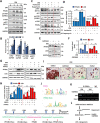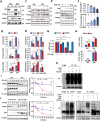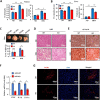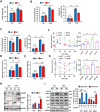Latexin deficiency attenuates adipocyte differentiation and protects mice against obesity and metabolic disorders induced by high-fat diet
- PMID: 35210404
- PMCID: PMC8873487
- DOI: 10.1038/s41419-022-04636-9
Latexin deficiency attenuates adipocyte differentiation and protects mice against obesity and metabolic disorders induced by high-fat diet
Abstract
Obesity is a risk factor for many chronic diseases, and is associated with increased incidence rate of type 2 diabetes, hypertension, dyslipidemia and cardiovascular diseases. Adipocyte differentiation play critical role during development of obesity. Latexin (LXN), a mammalian carboxypeptidase inhibitor, plays important role in the proliferation and differentiation of stem cells, and highlights as a differentiation-associated gene that was significantly downregulated in prostate stem cells and whose expression increases through differentiation. However, it is unclear whether LXN is involved in adipocyte differentiation. The aim of this study was to evaluate the role of LXN on adipocyte differentiation, as well as its effects on high fat-induced obesity and metabolic disorders. In this study, we determine the expression of LXN in adipose tissue of lean and fat mice by Western blot, qPCR and immunohistochemistry. We found that LXN in fat tissues was continuous increased during the development of diet-induced obesity. We fed wild-type (WT) and LXN-/-mice with high-fat diet (HFD) to study the effects of LXN on obesity and related metabolic functions. We found that mice deficient in LXN showed resistance against high-fat diet (HFD)-induced obesity, glucose tolerance, insulin tolerance and hepatic steatosis. In vitro studies indicated that LXN was highly induced during adipocyte differentiation, and positively regulated adipocyte differentiation and adipogenesis in 3T3-L1 cells and primary preadipocytes. Functional analysis revealed that the expression of LXN was positively regulated by mTOR/RXR/PPARɤ signaling pathway during the differentiation of adipocytes, while LXN deletion decreased the protein level of PPARɤ in adipocyte through enhancing FABP4 mediated ubiquitination, which led to impaired adipocyte differentiation and lipogenesis. Collectively, our data provide evidence that LXN is a key positive regulator of adipocyte differentiation, and therapeutics targeting LXN could be effective in preventing obesity and its associated disorders in clinical settings.
© 2022. The Author(s).
Conflict of interest statement
The authors declare no competing interests.
Figures








Similar articles
-
Adipocyte Septin-7 attenuates obesogenic adipogenesis and promotes lipolysis to prevent obesity.Mol Metab. 2025 May;95:102114. doi: 10.1016/j.molmet.2025.102114. Epub 2025 Feb 25. Mol Metab. 2025. PMID: 40015624 Free PMC article.
-
Coactosin-like F-actin binding protein (Cotl1) plays a key role in adipocyte differentiation and obesity.Commun Biol. 2025 Apr 17;8(1):628. doi: 10.1038/s42003-025-08062-3. Commun Biol. 2025. PMID: 40246959 Free PMC article.
-
Blueberry peel extracts inhibit adipogenesis in 3T3-L1 cells and reduce high-fat diet-induced obesity.PLoS One. 2013 Jul 25;8(7):e69925. doi: 10.1371/journal.pone.0069925. Print 2013. PLoS One. 2013. PMID: 23936120 Free PMC article.
-
Exercise-regulated white adipocyte differentitation: An insight into its role and mechanism.J Cell Physiol. 2023 Aug;238(8):1670-1692. doi: 10.1002/jcp.31056. Epub 2023 Jun 19. J Cell Physiol. 2023. PMID: 37334782 Review.
-
Adipocyte purinergic receptors activated by uracil nucleotides as obesity and type 2 diabetes targets.Curr Opin Pharmacol. 2022 Apr;63:102190. doi: 10.1016/j.coph.2022.102190. Epub 2022 Feb 26. Curr Opin Pharmacol. 2022. PMID: 35231671 Free PMC article. Review.
Cited by
-
Association of Body Composition with Pulmonary Function in Ningxia: The China Northwest Cohort.Diabetes Metab Syndr Obes. 2022 Oct 25;15:3243-3254. doi: 10.2147/DMSO.S383098. eCollection 2022. Diabetes Metab Syndr Obes. 2022. PMID: 36304482 Free PMC article.
-
Loss of LXN promotes macrophage M2 polarization and PD-L2 expression contributing cancer immune-escape in mice.Cell Death Discov. 2022 Nov 3;8(1):440. doi: 10.1038/s41420-022-01227-7. Cell Death Discov. 2022. PMID: 36323670 Free PMC article.
-
Latexin deficiency limits foam cell formation and ameliorates atherosclerosis by promoting macrophage phenotype differentiation.Cell Death Dis. 2024 Oct 18;15(10):754. doi: 10.1038/s41419-024-07141-3. Cell Death Dis. 2024. PMID: 39424784 Free PMC article.
-
Pancreatic cancer stemness: dynamic status in malignant progression.J Exp Clin Cancer Res. 2023 May 13;42(1):122. doi: 10.1186/s13046-023-02693-2. J Exp Clin Cancer Res. 2023. PMID: 37173787 Free PMC article. Review.
-
Zanthoxylum schinifolium extracts enhance 3T3-L1 adipocyte differentiation via CHOP inhibition and PPARγ activation.Anim Cells Syst (Seoul). 2025 Jul 25;29(1):469-487. doi: 10.1080/19768354.2025.2536022. eCollection 2025. Anim Cells Syst (Seoul). 2025. PMID: 40726805 Free PMC article.
References
-
- Heymsfield SB, Wadden TA. Mechanisms, pathophysiology, and management of obesity. N Engl J Med. 2017;376:254–66. - PubMed
-
- Piche ME, Tchernof A, Despres JP. Obesity phenotypes, diabetes, and cardiovascular diseases. Circulation Res. 2020;126:1477–1500. - PubMed
-
- Cinti S. The adipose organ. Prostaglandins, leukotrienes, Essent Fat acids. 2005;73:9–15. - PubMed
Publication types
MeSH terms
Substances
Grants and funding
- 31660242/National Natural Science Foundation of China (National Science Foundation of China)
- 81770310/National Natural Science Foundation of China (National Science Foundation of China)
- 82104496/National Natural Science Foundation of China (National Science Foundation of China)
- 2017GXNSFFA198003/Natural Science Foundation of Guangxi Zhuang Autonomous Region
LinkOut - more resources
Full Text Sources
Medical
Molecular Biology Databases
Research Materials
Miscellaneous

